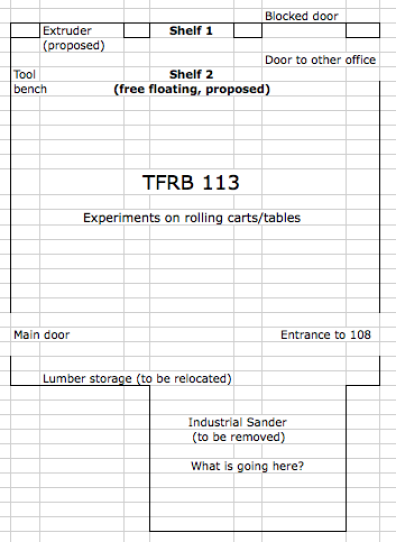We’re just over 1 month into refurbishing our new lab space in suites 108 and 113 of the Thermal Fluids Research Building (TFRB). We’re following the 5-S philosophy from Lean Manufacturing: 1) Sort, 2) Systemize, 3) Shine, 4) Standardize, and 5) Sustain. Recent posts have shown we’re nearing the end of phase 1 and are starting to look towards the design of our working systems within the space. What we decide matters. So what design rules can we follow to ensure the future productivity of the space?
I’ve written previously about the Constructal Law of thermodynamics dictating that systems will evolve to maximize flow-if left un-constrained. One of my favorite Dan Bukvich quotes is, “I’ve been to a lot of places (Universities) that are incredibly limited by the spaces they’ve designed for themselves.” This is another way of saying Donnella Meadows’ mantra from Thinking in Systems: A Primer that true systems thinkers typically don’t add barriers to spaces but rather seek to remove them wherever possible. Just remember though that not all barriers are physical, noise from a machine or a hot room can be barriers to emergent design thinking, the money or clearance required to tear down a wall may be barriers to change, the inability to communicate information through a lack of wi-fi or a projector can limit. This brings us to Rule 1: the core resources that must be sustained to enable an evolvable space facility for overcoming barriers are: 1) space, 2) time, 3) energy (a.k.a money and people), and 4) information (a.k.a. empathy). Of course my brain is wired to thermodynamics and this is similar to the 1st law of thermo; a surplus of one can help for deficiency in another (at a cost), you either have the necessary aggregate or you don’t, and this law alone does not describe how these resources change.
So what are the conditions necessary for promotion of our 4 key resources? I designed a pond ecosystem once. A good metric for predicting the biodiversity and sustainability of a pond ecosystem is the ratio of pond perimeter to pond surface area. –Most farmers make a circular pond because it’s easy with an excavator, and looks ‘done right’, however life has trouble in these areas because there are very few ways to interact with a circular convex geometry, i.e. the entropy is low. Life does well in high entropy (roughly described by high perimeter to surface area ratio) pond environments because it allows quick adaptation, in many ways, to change- which is analogous to our needs for this facility. This brings us to Rule 2: maximize the number of ways (or entropy) that you can use a space. Maximizing entropy in this sense doesn’t mean piles of junk everywhere, it means that you have spotless open spaces, along with scrap heaps for cannibalizing parts on a whim– and everything in between. You have spaces with standardized rules, and spaces for free form. You have spaces for business, spaces for clubs, spaces for research analogous to the co-working space movement.
In many ways the Constructal law (or design) law of thermodynamics isn’t a law at all– it’s just a natural manifestation of the first and second laws of thermodynamics– and if you really, I mean really understand just those two rules you too can create a space that evolves with you.
